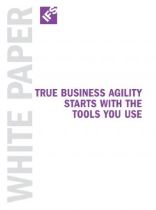
Download our most recent business agility whitepaper, which focuses on how the tools you use enable agility, improving the “handling characteristics” of your business.
Whether you are a dyed-in-the-wool auto enthusiast or just someone like me who has a more spirited driving style, you appreciate not only the power and speed a vehicle gives you, but the handling characteristics.
And what is handling? The dictionary definition will focus on the ability of a wheeled vehicle to handle corners and swerving maneuvers while remaining stable. But most of us think of handling as how a vehicle bends to our will in demanding, unpredictable environments. That twisting, turning stretch of rural highway, that mile of freeway where merging traffic makes unexpected lane changes par for the course. The vehicle sends signals back to you — telling you what the road feels like under your tires and the extent to which you have a firm grip on the road. The car bends to your will, responding immediately as you nudge the steering wheel a bit one way or the other. It holds flat to the road through that tight turn at 45 mph, just as you knew it would. This makes you smile, and sometimes, it keeps you safe.
Car and Driver devotes countless, breathless and hushed words to handling, trying to quantify it and praising vehicles that possess more favorable handling characteristics. In the Car and Driver shootout article, an engineer from BMW spelled out that company’s philosophy towards achieving great handling characteristics:
“Good handling is a well-controlled body, good steering response, good steering feedback, and well-balanced integration—with all of the different systems tuned together so that none is sticking out,” M3 Chassis Engineer Uli Phundmeier said.
Corvette Chief Vehicle Engineer Tadge Juechter stressed the importance of the relative degree of stiffness of various structural and handling components.
“On the Corvette, we want the body structure to be 10 times stiffer than the chassis member at the attachment points,” he said. “Everything between you and the road—the steering wheel, the column torsional stiffness, the column mount—needs to do its best to transmit your action to the tire contact patch. Tight tolerances and low friction produce feedback as well.”
Handling is not about raw acceleration, torque and speed. That heavily modified, hot-rodded muscle car might perform adequately in an illegal street race along a straightaway. But in the real world, amongst the twists and turns and unanticipated events of actual driving, handling becomes more important. Each component must be designed to work as part of a finely tuned whole. And herein lies an important lesson for our businesses. In the real world, we, too, need tools that are designed for handling, for agility and for responsiveness.
The tools we use to run our business are crucial elements in our ability to take that next curve the market throws at us. The best driver in the world would not perform as well on a slalom course driving a minivan as this Porsche 911 Carrera. And the most competent executive team will have a hard time adapting to changing patterns in customer demand, mergers, acquisitions and other sea changes affecting the business if they rely on enterprise systems that obscure essential information and market signals from them and cannot easily be reconfigured so the business can change course.
In this, the second of our whitepaper series on business agility, we take a closer look at how enterprise software tools need to facilitate business agility. How well does enterprise software “handle?” How exactly do business systems up to and including enterprise resource planning (ERP) contribute to business agility?
Download the whitepaper today to find out! And let us know what you think about the role of enterprise software in improving the handling characteristics of your business.
